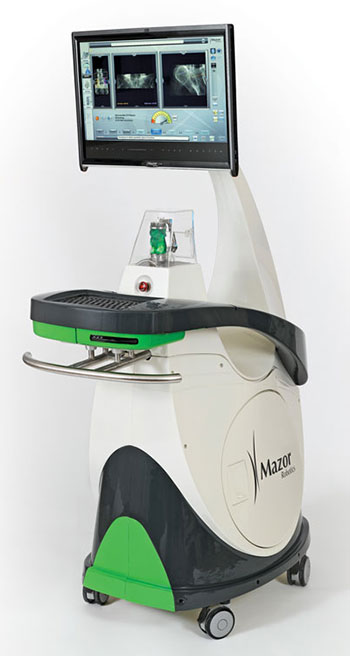Christopher Prentice represents exactly the kind of company that increasingly is finding a home along U.S. Gulf Coast — high-tech, international and rapidly growing.
As vice president of global marketing for Mazor Robotics Inc., Prentice is busy establishing the U.S. headquarters of an Israeli company that specializes in the development of innovative surgical robots and complementary products.
The fact that he’s doing it in Orlando is indicative of a sea change in industrial growth and development throughout the five Gulf Coast states of Florida, Alabama, Mississippi, Louisiana and Texas.
“We knew we had to establish a commercial headquarters in America, and so we looked at New York City, Boston, Dallas and Atlanta,” says Prentice. “When we discovered the advances being made in the medical science industry in Orlando, we decided to build a relationship with Florida Hospital and that ultimately led us to select Central Florida for our first official U.S. headquarters.”
While tourism, fishing, agriculture, logistics, aerospace, mining, steel, timber harvesting, and the oil and gas industry have long dominated the economy of the Gulf Coast, a new wave of multinational investment is reshaping the region’s profile.
From Mazor in Orlando to Australian-based Incitec Pivot in Jefferson Parish, La., foreign direct investment has become the catalyst for transforming a Gulf Coast economy that for centuries has made its living off the resources of the land and sea.
It still does, but now it does so with a healthy assist from innovative entrepreneurs who are bringing a flood of investment capital to the South from across the seas.
In Orlando, the theme park capital of America, Mazor is leading the way by bringing high-tech engineering from Israel to one of the fastest-growing life-science clusters in the U.S. The establishment of the new medical school of the University of Central Florida, along with the ongoing development of the new Medical City complex in Lake Nona was a pivotal factor in the equation that lured Mazor, says Prentice.
“The plan is to have about 35 to 50 employees in Orlando over the next two years,” he says. “As the year progressed over our due diligence period when we were conducting our U.S. site search, we found a lot of reasons to like Florida. The economic climate is very good here, the weather in Florida is very much to our liking, and Orlando really showed the interest. The governor called. The mayor called. We really felt wanted here.”
Currently housed in the Plaza Office Building near Lake Eola in downtown Orlando, Mazor plans to move into a new bio-research building in the Health Village near the campus of Florida Hospital.
“We are based in Caesarea in Israel,” notes Prentice. “This is our first true headquarters operation outside of Israel. We also have one office in Germany and a logistical operation in Norcross, Georgia. Our supply-chain model calls for parts to come from Taiwan and Switzerland and other places and then be assembled in Israel. From there, products will be shipped to Orlando.”
Having access to “a premier health-care system like Florida Hospital” was a critical factor for Mazor, says Prentice, along with the welcoming of the city government and the state government and the economic development leaders of the state.
“Plus, the simulation industry is here,” he says. “A lot of high-tech talent is here that we can pull from.”
A Medical Alliance Forms
Another multinational life-science company — Profil Institute for Clinical Research Inc. — is also finding a new home in Orlando. A renowned center for diabetes and obesity early-phase clinical research, Profil is establishing its first East Coast location through a joint venture with Florida Hospital.
Based in Chula Vista, Calif., near San Diego, Profil also employs researchers at the WHO Collaborating Center of Diabetes at the Heinrich-Heine University of Dusseldorf in Germany; Columbia University; the University of Michigan; and Harvard University.
Profil is investing $2 million into a new 9,500-sq.-ft. (883-sq.-m.) facility that will create 75 new jobs over the next five years in Orlando. The firm is partnering with the Florida Hospital-Sanford-Burnham Translational Research Institute (TRI) to establish an early-phase clinical services center for metabolic disease research.
“We selected Orlando because we found the partner we wanted here,” says Dr. Linda Morrow, chief operating officer for Profil. “Florida Hospital’s commitment to the Translational Research Institute was a great match for us and what we do. They were looking for a partner who had clinical experience in diabetes and metabolism research. It was really the right fit.”

Orlando may be known worldwide as America’s No. 1 tourist destination, but the Central Florida city is rapidly becoming known as a preferred location for expanding life-science companies.
Photo courtesy of Metro Orlando EDC
Morrow says that the new hires will come mostly from the Orlando area and will be in high-paying positions such as physicians, nurses and project managers.
“Orlando has made a big commitment to the development of clinical research and medical care,” she says. “Florida Hospital has partnered well with the City of Orlando to push this forward. The presence of the Sanford-Burnham Institute was key as well. It was really the total package that convinced us to come here.”
Mazor and Profil were just two of at least eight major life-science project wins for Orlando in 2012. The others included DaVita Rx LLC (100 jobs and $8.75 million in capital investment); Catalyst Rx (300 jobs); Prime Therapeutics (213 jobs and $18.1 million); BeneCard PBF (150 jobs); AcariaHealth (80 jobs); and Axium Healthcare Pharmacy Inc. (90 jobs).
Even larger investments are coming to Louisiana. On April 17, Dyno Nobel America and its parent company — Incitec Pivot of Australia — announced a $1-billion facility investment for a new ammonia production plant and related upgrades in Waggaman in Jefferson Parish near New Orleans.
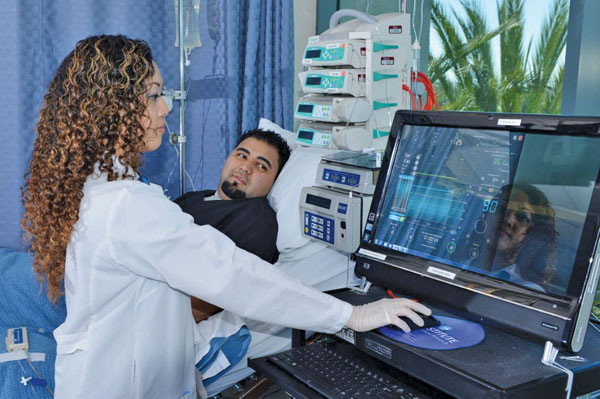
Profil Institute for Clinical Research Inc., based in California, is opening its first East Coast clinical research center in Orlando, thanks to a new partnership with Florida Hospital.
Photo courtesy of Profil Institute
The new Dyno Nobel plant will produce 800,000 metric tons of ammonia per year at Cornerstone Chemical’s Fortier Manufacturing Complex on the west bank of the Mississippi River.
The project creates 65 new direct jobs that pay an average annual wage of more than $55,000.
An additional 750 construction jobs will be created over the three years that it will take to build the project.
“This plant will set a new standard in clean, efficient ammonia production and will provide a significant economic benefit to the state and regional communities,” said James Fazzino, managing director and CEO of Incitec Pivot.
A Changing Economic Model
Dyno Nobel will begin construction in the second quarter of this year, with initial ammonia production slated to begin by late 2016.
“The U.S. Gulf Coast economic model has changed due to the advent of advanced drilling and extraction techniques and the associated impact on natural gas pricing,” said Greg Zoglio, CEO of Cornerstone Chemical. “Incitec Pivot’s foresight of this paradigm shift, coupled with the brownfield offering by Cornerstone Chemical Company and project support provided by the state of Louisiana, will allow the resurgence of world-class ammonia production in the state.”
Several other large corporate facility investments made headlines along the Gulf Coast recently:
- EADS Airbus broke ground April 8 on a $600-million aircraft assembly plant at the Brookley Aeroplex in Mobile, Ala. About 1,000 workers will be hired to assemble the A320 passenger jet for Airbus.
- Huntsman Corp. announced a $78-million investment on March 21 at its Geismar chemical manufacturing plant in Louisiana, creating 17 new direct jobs that pay an average annual salary of $92,000.
- Kinder Morgan Energy Partners LLP announced a $58-million expansion of its chemical storage capacity in Geismar on April 1. The firm also announced a $170-million expansion of the new petroleum condensate processing facility that it is building near the Galena Park terminal on the Houston Ship Channel in Texas.
- CenturyLink broke ground March 4 on a 250,000-sq.-ft. (23,225-sq.-m.) headquarters expansion in Monroe, La., where the firm will add 800 jobs.
- Katoen Natie USA announced a $150-million petrochemical storage and processing facility in the Baton Rouge area on March 6, creating 210 new direct jobs.
- Florida-based BioNitrogen Corp. announced plans in April to build five fertilizer plants in Pointe Coupee Parish, La., totaling $1.25 billion in capital investment.
- Turkey-based Borusan Mannesmann Pipe announced April 2 that it will expand its manufacturing operations to the U.S. with a steel pipe plant in Baytown, Texas, creating 250 jobs and $148 million in capital investment.
- Accenture announced earlier this year that it will open a software development and support center in Austin, creating about 300 new jobs by the end of the year.
Billion Dollar Bayou
Laissez les bons temps rouler!
The famous French Cajun mantra translates to, “Let the good times roll!” Residents in Louisiana’s capital city heartily chant it over mouthfuls of boiled crawfish. Oui, monsieur, these are good times for Baton Rouge!
BASF, ExxonMobil, Dow Chemical, EA Sports, IBM. These are just a few of the corporate powerhouses choosing to locate new facilities in Baton Rouge in the last 12 months. Perhaps nowhere on earth has a region of fewer than 1 million people seen such a concentrated influx of billion-dollar projects, or enjoyed such sustained job growth in challenging economic times.
Since January 2012, Baton Rouge has attracted 47 new projects representing a capital investment of just over $6.7 billion. Laissez les bons temps rouler indeed.
A game-changer for Baton Rouge
As this magazine went to press, IBM guaranteed the good times would keep rolling by announcing its plan to build a sleek new services center along the Mississippi River. This new investment in the heart of downtown Baton Rouge will create 800 new jobs and transform the city’s skyline.
“It’s a game-changer,” said Baton Rouge Area Chamber Executive Director Iain Vasey. “It’ll alter the city’s skyline forever.”
Location, Location, Location?
Nope. For modern-day companies it’s People, People, People! The IBM decision is a testament to the changing landscape of corporate investment.
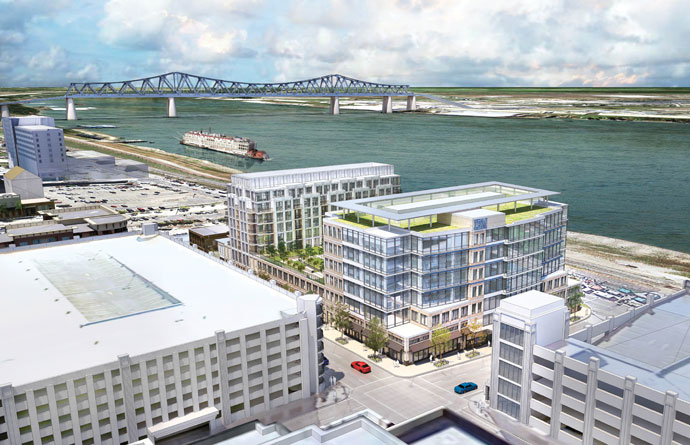
IBM is building a new service center that will employ 800 people along the banks of the Mississippi River in Baton Rouge.
Image courtesy of IBM
“Everything that drives that deal is about the labor,” said Vasey, “The reality is that incentives packages don’t always make the difference. In some deals 80 percent of the cost factoring is the availability of the labor. Cost and availability of qualified labor are absolutely the largest driving factors in any deal of this nature. The partnership with LSU and other state universities which will turn out a skilled labor force gave Baton Rouge a competitive advantage.”
LSU will triple the size of their computer engineering programs to support IBM. It’s a three-year ramp-up, supported by Louisiana Economic Development (LED), and will recruit state-wide to identify qualified workers.
Cameron Art, General Manager of Application Management Services for IBM, agrees. “In any decision like this there are myriad factors that contribute to the decision. But for us it ultimately came down to the strength of the technology skills pipeline — the sheer potential of the people in Louisiana — and the quality of the partnership we’re building with the public sector on multiple levels — the state, Baton Rouge and the university system.”
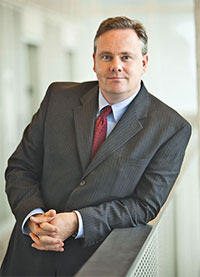
“It’s a game-changer.“
— Iain Vasey, executive director, Baton Rouge Area Chamber
IBM plans to stay a while, implementing a long-term strategy to develop talent from Louisiana’s rich labor pool. Cameron Art noted that IBM “took this step to build the supply of high-value skills we can apply to our clients’ most important business transformations, and we believe this partnership advances that strategy in very powerful ways.”
We’re # 1!
According to a 2012 U.S. Chamber study, Louisiana was tops in the nation for export growth and second in the nation for income growth. A booming energy sector and aggressive business attraction policies by state and regional agencies helped Louisiana achieve nearly a dozen Top 10 rankings in Enterprising States 2012, a comprehensive report by an affiliate of the U.S. Chamber of Commerce. From 2001 through 2011, Louisiana’s exports grew at a cumulative rate of 232 percent, more than doubling the growth rate of the U.S. at 103 percent for the same period.
“We can handle that.”
The slogan of the deep water port of Greater Baton Rouge — “We can handle that” — could rightly be applied to the entire region, but there’s no doubting the vital role the port plays in Baton Rouge’s economic renaissance. The furthest inland deepwater port on the third largest river in the world is in the middle of the largest capital improvement in its history. The Enterprising States 2012 report credits Louisiana’s success in part to continued investments in its port infrastructure. Investors have taken note. Iain Vasey reports, “Even with the state of the national economy, Louisiana’s Gulf Coast is looking at more deals than at any other time in our history.”
Perennial Players
Site Selection magazine’s Governor’s Cup rankings placed Baton Rouge #1 among Top Metros in 2011 and, and they’ve ranked no lower than fourth since 2008. This issue recognizes their success with a prestigious Best to Invest Award.
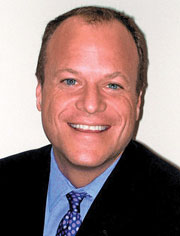
Cameron Art, General Manager of Application Management, IBM
Much of this can be attributed to the state’s comprehensive restructuring of its workforce development system, including the creation of the aforementioned LED FastStart program, and an extension of the Quality Jobs Tax Credit program. Add to that an expansion of Louisiana’s Research & Development Tax Credit program and you’ve got a recipe for success.
Success Brings New Challenges
The rapid growth of the region and influx of new workers has created its own set of challenges for Baton Rouge. With just 45.7 percent of its jobs located in neighborhoods with public transit service, Baton Rouge’s transit coverage ranks 97 out of the nation’s 100 largest metro areas, according to a new Brookings Institution analysis of data from 371 transit providers. The report also indicates just 19.3 percent of Baton Rouge residents can reach their job within 90 minutes via public transit, which places it 73rd in the nation. On the other hand, CNN Money notes that the median commute time in Baton Rouge is among the best in the US, and the percentage of the city’s population with commutes of 45 minutes or longer is half the national average.
The area’s leaders are aware of the problem. The city’s Capital Area Transit System (CATS) is undergoing a thorough review of its funding, management structure and routes. Though there’s no plan yet in place, Iain Vasey acknowledges the need for improvement. “There’s a recognition that much more needs to be done to figure out how best to serve the community and get folks to the employment centers,” he says.
Based on recent history, this magazine is betting they’ll figure it out, and will keep the local economy — and the good times — rolling.
